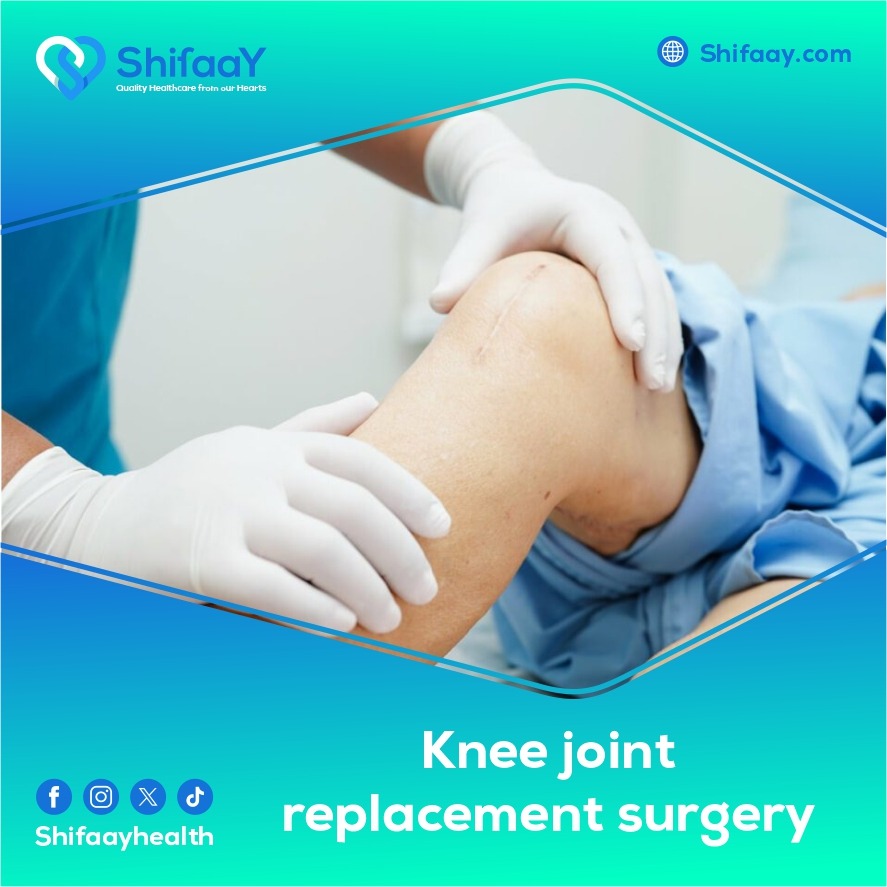Knee joint replacement surgeries
Most often, a range of joint infections can affect the knee, requiring a knee joint replacement surgery if the patient’s health is not managed. These infections and diseases can be brought on by aging, injuries sustained during sports, and a host of other factors.
Given everything, it might be challenging to use medication if the patient is running behind schedule, necessitating a quicker operation to ensure a full recovery. In the sections that follow, we will cover everything from the price of knee joint replacement surgery to the various kinds of operations that are available, the factors that typically lead to these procedures, how they are carried out, and how to heal properly to avoid further injuries.
Reasons for knee joint replacement surgery

The aim of knee joint replacement surgery is to restore knee functions that have been affected by arthritis or injuries. After the procedure, many patients report feeling incredibly comfortable and having more range of motion. The following are some of the primary causes of this procedure:
● Arthritis: Osteoarthritis, which affects the cartilage in the knee joints, is the most common reason for knee joint replacement surgery.
● Rheumatoid arthritis: This type of arthritis affects the tissues surrounding the joint, causing pain and swelling.
● Injuries: Some injuries, such as a torn anterior cruciate ligament or a fracture of the femur, can damage the cartilage and tissue of the knee, requiring knee joint replacement surgery
● Congenital deformities: Certain congenital deformities, such as a lack of cartilage or deformities in the knee bones, may necessitate a knee joint replacement surgery.
Also follow: Symptoms of osteoarthritis of the hip joint
Knee joint replacement surgery for the elderly
For the elderly, who frequently suffer from osteoporosis or arthritis, this operation may provide a new opportunity to return to a more active and pain-free life, but the most important question is why a knee joint replacement surgery is required for the elderly.
First of all, the elderly are more likely to develop osteoarthritis, one of the most common diseases affecting the knee that results in cartilage erosion and damage, muscle spasms, and excruciating pain, making the surgery absolutely necessary. As a result, exercise becomes more difficult as people age, and everyday activities like walking and climbing stairs become more difficult for elderly individuals.
As knee pain worsens over time, it can prevent seniors from engaging in daily activities, which can have a negative impact on their social lives, physical activity, and mental health. Knee pain in the elderly can make it difficult for them to move around normally, which can lead to inflammation and muscle weakness in other parts of the body. This affects not only the mobility of the elderly but also their general health.
Pain relief is the primary benefit of knee joint replacement surgery, though there are additional advantages as well. A knee joint replacement surgery significantly enhances quality of life and helps eliminate persistent knee pain. It also enables the patient to walk and climb stairs more easily and freely than before.
It encourages the patient to resume previously favored hobbies, like walking or sports. It also enables the patient to rely on himself to complete his daily tasks without the need for assistance from others.
The procedure improves older people’s overall health by allowing them to exercise and move more effectively, lowering their risk of chronic diseases.
Knee swelling after joint replacement surgery
As we have previously stated, knee joint replacement surgery is a delicate surgical procedure requiring careful attention and the services of a specialized surgeon due to its potential risks, the most significant of which is knee swelling. In the days and weeks following the operation, the knee becomes swollen and painful, which raises concerns for many patients. We find that the causes of knee swelling after the operation include:
● Inflammation: Inflammation is normal after surgery due to surgical wounds and changes in the joint environment.
● Bleeding: In some cases, bleeding may occur within the joint, causing swelling.
● Fluid accumulation: Fluid accumulation around the joint can cause swelling.
● Movement increases blood flow to the knee and may cause swelling.
● Stress on the knee, as well as smoking, can contribute to swelling.
Dear Patient, in order to help you reduce swelling and avoid more, it is advised that you limit your knee movement in the early postoperative days.
● Compression on the knee with special bands reduces swelling.
● Applying cold compresses to the knee for a short period several times a day is one of the most effective ways to relieve swelling and pain.
● The doctor may prescribe some anti-inflammatory medications or painkillers to relieve swelling and pain.
● Post-operative physical therapy helps strengthen the muscles surrounding the joint, improve knee movement, and reduce swelling.
● Regular exercises after the operation contribute to improving blood circulation, eliminating fluid accumulated in the joint, and reducing swelling.
● In some cases, the doctor may prescribe diuretic medications to get rid of fluid accumulated in the knee and relieve swelling.
Despite this, it is still crucial to schedule routine follow-up visits with the orthopedic doctor after the procedure to ensure that the swelling is under normal limits and that no complications develop. You should also monitor any changes in the swelling’s temperature, color, or size and promptly report them to the doctor.
Cost of knee joint replacement surgery
There are multiple factors that influence the total cost of knee joint replacement surgery, such as:
● Technology and Design: Advanced joints with sophisticated fastening systems are frequently more expensive.
● Quality and Durability: High-quality joints rely on materials and designs that ensure their durability for a longer period, which increases their cost.
● Accompanying medical services: include doctor’s evaluation, surgery costs, post-operative rehabilitation, and physical therapy.
● Hospital or center: Costs vary depending on the geographical location and the hospital where the surgery is performed.
If you are considering knee joint replacement surgery, you should definitely consult with a specialist doctor. They can evaluate your needs and give you the best advice regarding the type of joint you need.
Make sure you accurately calculate all of the costs involved in the procedure, including the cost of the joint, as well as any aftercare.
Types of artificial knee joints and their prices
The knee is regarded as one of the most vulnerable joints to injury and wear due to the high pressures it bears while walking, running, and performing other daily activities. When cartilage is damaged or eroded beyond surgical repair, artificial knee joints may be the only solution to restore movement and relieve pain. There are several types of artificial knee joints, which are classified according to the technology used and the type of movement performed. The most important of these types are:
● Fixed joints
These are the most common joints, and they are typically used for patients who have knee wear that is not associated with a major deformity.
In this case, the upper prosthetic part is securely fastened to the femur and the lower part to the scaphoid bone.
● Movable endothelial joints
These joints have a movable endothelial surface that allows for a smoother rhythm and rotation in different directions, resulting in easier and more natural movement. This type is ideal for active patients who require a high level of flexibility.
● Position-specific joints
It is distinguished by the existence of a mechanism that prevents slippage between the femur and the abductor and aids in knee stabilization. This type is commonly used in cases of knee instability.
There are several more types of artificial knee joints, like:
● Metal-plastic joint.
● Ceramic hinge on plastic.
● Ceramic-on-ceramic joint.
● Metal-on-metal joint.
Pain after knee joint replacement surgery
The knee joint replacement procedure is performed under general anesthesia in the operating room, and the pain afterward can last for two weeks to a full month. The following are the main steps:
● Making a surgical incision: The surgeon makes an incision at the front of the knee.
● Removal of the damaged surface: The surgeon removes the damaged surface of the femur and tibia.
● Installation of replacement components: The knee is fitted with replacement parts consisting of metal and plastic. These parts include a tibia and femur joint surface replacement.
● Component fixation: The replacement components are fixed with surgical cement, allowing the knee to move freely and painlessly.
● Closing the incision: The surgical incision is sutured and bandaged.
After the procedure, the patient needs to stay in the hospital for a few days to ensure his wound heals before going home. The home recovery program includes the following:
● Physical therapy: With the use of crutches or other supportive devices, the patient can regain range of motion, strengthen the muscles in their knees, and start walking again.
● Medication: In order to minimize the risk of infection and to relieve pain and swelling, the doctor may recommend certain medications.
● Wound care: In order to avoid infection, the patient needs to take good care of the wound and keep it clean.
Tips after knee joint replacement surgery
In order for you to fully recover, dear patient, there are a few guidelines that you need to pay close attention to and follow carefully. The most crucial ones are as follows:
● First, keep the surgical incision clean
You must not touch the surgical sutures or expose them to water in order to avoid infections or complications. The bandage needs to be changed daily to avoid infection of the wound.
● Secondly, follow a healthy diet
After this kind of surgery, most patients lose their appetite. This is normal and should be accommodated, but in order to promote healing and help your muscles regain strength, you should make sure you are eating foods high in iron.
● Third, do light exercise
It is necessary to perform physical therapy sessions to strengthen your knee joint and activities like walking gradually around the house to improve your range of motion, including sitting, standing, and climbing stairs, three to six weeks after surgery.
● Fourth, do not jump, shake the knee joint, or bend the knee in kneeling and prostrating positions.
Look for signs of infection, such as redness, swelling, or fluid leaking from the surgical incision.
Side effects of knee joint replacement surgery

There are some anesthesia-related side effects that may happen following knee joint replacement surgery, including nausea, vertigo, tremors, chills, sore throat, body aches, and leg stroke.
Shifaay Center’s specialist doctors can prevent these side effects by explaining to the patient the range of harms that occur, such as:
● Wound infection.
● Damage to nearby nerves or tissues.
● Problem with the new artificial knee.
● Difficulty bending the knee.
● Persistent pain or stiffness in the knee joint.
● Feeling of knee instability while walking or running.
However, there is never a need to worry because medical professionals handle any complications that patients may face. Reach out to Shifaay center, the best medical tourism center in Egypt right now to receive the services you need at the most affordable prices and in the shortest amount of time.
When is the complete recovery from knee joint replacement surgery?
In most cases, a patient recovers in three to six days; the precise duration depends on the patient’s condition, degree of pain control, and nature of the injury. However, it is worth noting that a complete recovery may take 4 to 6 months, depending on the condition of each patient.
How long does pain last after knee joint replacement?
In many cases, it may take a number of weeks to months until they can fully improve and not feel pain, and it may probably take from two weeks to a month after the surgery is performed successfully.






